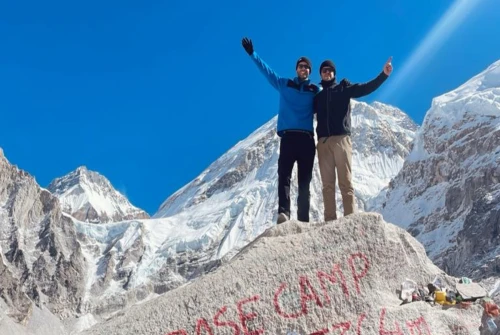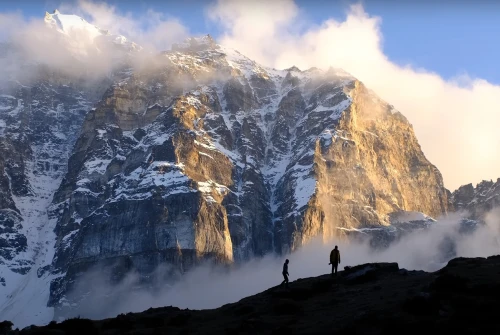What to Look for in Trekking Boots for the Everest Base Camp Hike
When preparing for the Everest Base Camp trekking route, choosing the right pair of boots requires careful consideration of several key factors.
First, fit and comfort should be your top priority. Since the EBC hike involves long walking days, your boots must feel snug but not overly tight, with enough room for your toes to move freely. A poor fit can cause painful blisters and sore feet, which will only worsen as the trek progresses.
Second, make sure you give your boots a proper break-in period before you set off for Lukla. Walking at least 40–60 kilometers in them beforehand helps soften the material and adjust the fit to your feet. Wearing brand-new boots on the EBC trek is a recipe for discomfort and injury.
Another important factor is waterproofing. The Mt. Everest Base Camp trek includes river crossings, snowy paths, and occasional rainfall, making it essential to choose boots with reliable waterproof technology such as Gore-Tex. Dry feet not only feel more comfortable but also reduce the risk of blisters and fungal infections.
Equally crucial is ankle support. The rocky, uneven trails of the Everest Base Camp trekking route can easily cause twists or sprains, especially when you’re tired at higher altitudes. Mid-to-high cut boots provide the stability and protection you need in these conditions.
You should also pay attention to traction, as the terrain includes everything from loose gravel to icy patches. A strong outsole with excellent grip, such as those made from Vibram rubber, ensures better stability and safety throughout the EBC trek.
Lastly, consider the balance of durability and breathability. Since the Everest Base Camp hike lasts almost two weeks, your boots must be tough enough to withstand constant wear while also allowing airflow to keep your feet dry and comfortable. Boots that trap too much heat or moisture can quickly become uncomfortable during long trekking days.
In short, the right trekking boots for Everest Base Camp trekking should fit well, be properly broken in, remain waterproof, offer strong ankle support, provide solid traction, and balance durability with breathability. By keeping these factors in mind, you’ll be well-prepared for a safe and enjoyable journey to the foot of the world’s highest mountain.
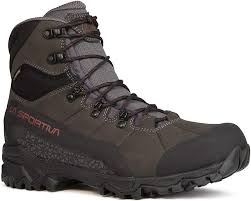
Types of Trekking Boots for Everest Base Camp Trek
Lightweight Hiking Boots
Lightweight boots are best for experienced trekkers who already know the Everest Base Camp trail and want more flexibility. They are comfortable and easy to walk in for short treks, but they provide very little ankle support. For the rocky and uneven terrain of the Mt. Everest Base Camp trek, these boots are not the ideal choice.
Mid-Weight Trekking Boots
Mid-weight trekking boots are the most suitable option for the Everest Base Camp trek. They provide the perfect balance of comfort, durability, ankle support, and protection for long trekking days. While they may require a break-in period before starting the EBC hike, once softened, they perform exceptionally well on the Everest trail. These boots are highly recommended for first-time EBC trekkers as well as regular hikers.
Heavy Mountaineering Boots
Heavy mountaineering boots are designed for technical climbs and high-altitude peaks like Island Peak or Mera Peak, not for the standard Everest Base Camp trek. They are well-insulated, stiff, and built to withstand extreme cold, making them great for climbing expeditions. However, they are too heavy, uncomfortable, and unnecessary for the EBC trekking route.
Final Verdict: The best boots for Everest Base Camp Trekking are mid-weight, waterproof trekking boots with solid ankle support and strong grip. These provide the right balance of comfort, safety, and durability for the two-week Everest Base Camp adventure.
Weather and Seasonal Considerations for EBC Trekking Boots
When planning your Everest Base Camp trek, it’s important to choose trekking boots that match the season and trail conditions.
- Spring (March–May): During spring, the trails can be wet and muddy due to melting snow in the Khumbu region. For this reason, waterproof hiking boots are essential to keep your feet dry and comfortable during the EBC hike.
- Autumn (September–November): Autumn is considered the most popular trekking season for Everest Base Camp because of its clear skies and stable weather. Mid-weight trekking boots are ideal during this period, providing the right balance of comfort, durability, and ankle support for long days on the Everest Base Camp trekking route.
- Winter (December–February): Winter brings snow and icy conditions along the EBC trail. To stay safe and warm, insulated and waterproof boots are highly recommended for Mt. Everest Base Camp trek, especially if you plan to reach higher points like Kala Patthar or explore nearby high-altitude trails.
- Monsoon (June–August): Monsoon season makes the trails extremely muddy and slippery. If you attempt the EBC hike during the monsoon, you must wear waterproof boots with strong grip, as well as gaiters, to prevent slips and keep your feet dry in the wet conditions.
By selecting boots appropriate for the season, you ensure maximum comfort, safety, and performance on your Everest Base Camp adventure.
Features to Look for in Everest Base Camp Trekking Boots
Choosing the right trekking boots for the Everest Base Camp trek requires paying attention to several essential features that ensure comfort, safety, and performance throughout the journey.
First and foremost, your boots should be waterproof, preferably with a Gore-Tex lining, to keep your feet dry during snow, rain, or river crossings along the EBC trekking route. Dry feet are crucial to prevent blisters and maintain comfort on long days of trekking.
Next, look for mid-to-high ankle support, which is vital for the rocky and uneven trails of the Mt. Everest Base Camp trek. Strong ankle support reduces the risk of sprains and provides stability when walking over steep or slippery terrain.
A Vibram sole or similar high-traction outsole is another key feature. These soles provide excellent grip on rocks, mud, and icy patches, making them ideal for navigating challenging sections of the EBC hike safely.
For all-day trekking, a cushioned midsole is important to absorb impact and reduce fatigue. Boots with adequate cushioning ensure that your feet stay comfortable during long hours on the Everest Base Camp trail.
While durability is important, your boots should also be lightweight enough to avoid tiring your legs during multi-day trekking. The best boots strike a balance between toughness and manageable weight, suitable for the two-week EBC trek.
Finally, ensure that your boots are compatible with gaiters, especially if you plan to trek in winter or snowy conditions. Gaiters prevent snow, mud, and small rocks from entering your boots, keeping your feet dry and protected throughout the Everest Base Camp trek.
By choosing boots with these features, you’ll be well-prepared for the Everest Base Camp trekking experience, with better comfort, safety, and performance on every step of the journey.
Top 10 Best Boots for Everest Base Camp Trek
Right now, there are a wide variety of trekking boots and brands available, and many of them are of very high quality. While everyone’s feet are different, we’ve put together Ten of our top recommendations for Everest Base Camp trekking boots. Keep in mind, if a boot you like isn’t on this list, it doesn’t mean it isn’t a great option for the EBC hike.
Salomon Quest 4D 3 GTX – Best Overall for EBC Trek
The Salomon Quest 4D 3 GTX is widely regarded as the best overall boot for Everest Base Camp trekking. Designed for long multi-day treks, it combines stability, lightweight construction, and exceptional waterproofing, making it ideal for both rocky paths and muddy trails. Its mid-to-high ankle support reduces the risk of sprains, while the Vibram sole ensures reliable traction on snow, ice, and uneven terrain. Many trekkers choose this boot for its versatility across all EBC seasons, from spring snowmelt to autumn clear skies.
Pros: Durable, comfortable for multi-day trekking, excellent grip, great ankle support.
Scarpa Zodiac Plus GTX – Best for Rocky and Rugged Terrain
The Scarpa Zodiac Plus GTX excels on rocky, uneven sections of the Everest Base Camp trek. Its Vibram sole provides outstanding traction, while the Gore-Tex waterproof lining keeps your feet dry during river crossings or snowy sections. The boot features excellent ankle support and a robust lacing system for a snug, secure fit. Lightweight yet durable, it is ideal for trekkers tackling challenging terrain on the EBC hike, especially for those who prioritize stability and grip.
Pros: Strong traction, durable, waterproof, highly stable, ideal for rough Himalayan trails.
La Sportiva Nucleo High II GTX – Best for Ventilation and Lightweight Comfort
The La Sportiva Nucleo High II GTX is lightweight, breathable, and warm, making it perfect for trekkers with sweaty feet during the EBC hike. Its Gore-Tex Surround technology provides waterproofing while maintaining airflow, ensuring feet stay dry and comfortable even during long days. The firm sole provides excellent support for rocky and uneven paths, while the lightweight design prevents fatigue over the 12–14 days of Everest Base Camp trekking.
Pros: Breathable, supportive, lightweight, suitable for all-season trekking.
Lowa Renegade GTX Mid – Best Comfort Right Out of the Box
The Lowa Renegade GTX Mid is one of the most popular boots among Everest Base Camp trekkers due to its comfort straight out of the box. With excellent ankle support and waterproofing, it handles long hiking days with ease. Its cushioned midsole absorbs shock, reducing foot fatigue on rocky trails. This boot is particularly suitable for first-time EBC hikers who want reliable performance without a long break-in period.
Pros: Comfortable, durable, stable, waterproof, ideal for long trekking days.
Merrell Moab 3 Mid Waterproof – Best Budget-Friendly Option
The Merrell Moab 3 Mid Waterproof is a budget-friendly option that still offers solid performance for Everest Base Camp trekking. It provides good ankle support, waterproofing, and cushioning, making it suitable for moderate rocky trails and muddy paths. Trekkers with a wider foot or who prefer extra toe box space find this boot particularly comfortable. While less premium than some other models, it offers excellent value for money for EBC trekkers.
Pros: Affordable, comfortable, reliable waterproofing, lightweight, versatile.
La Sportiva Trango TRK GTX – Best for Durability and Stability
The La Sportiva Trango TRK GTX is built for long-distance trekking and multi-day EBC hikes. Its Vibram sole ensures excellent traction on rocky and uneven terrain, while the padded design provides comfort during steep ascents or descents. The combination of flexibility and heel support makes it stable yet responsive. It is also waterproof and warm, making it a reliable choice for early spring snowmelt or late autumn treks.
Pros: Durable, flexible, warm, excellent traction, reliable for high-altitude trekking.
Meindl Vakuum – Best for Cold Feet and Long-Distance Trekking
The Meindl Vakuum is a favorite among trekkers who need extra warmth and long-distance comfort. Its custom-like fit reduces blisters, and the boot’s durability ensures it lasts through multiple treks in Nepal. Perfect for EBC trekking in winter or spring, it provides good insulation and excellent support over rocky, mixed terrain. Many seasoned trekkers wear Meindl Vakuum for both Everest Base Camp treks and other Himalayan expeditions.
Pros: Warm, durable, excellent for mixed terrain, ideal for high-altitude trekking.
Salomon Quest 4 GTX – Best Versatile Trekking Boot
The Salomon Quest 4 GTX is slightly different from the 4D model but remains an excellent choice for Everest Base Camp trekking. It is durable, waterproof, and comfortable, offering good support for long days on the trail. Its versatility makes it suitable for other Himalayan treks as well, providing a reliable boot for trekkers looking for performance across multiple trekking routes.
Pros: Versatile, durable, waterproof, supportive for multi-day hikes.
Scarpa Zodiac TXS GTX – Best Lightweight Option
The Scarpa Zodiac TXS GTX is lighter than the Zodiac Plus but still provides excellent ankle support and waterproof protection. Its lighter weight makes it perfect for trekkers seeking less fatigue during Everest Base Camp hiking. With a robust Vibram sole, it offers traction for rocky and uneven terrain while remaining flexible enough for easier maneuverability.
Pros: Lightweight, supportive, durable, waterproof, good for long multi-day trekking.
Merrell Moab Mid 2 Waterproof – Best for Wider Feet
The Merrell Moab Mid 2 Waterproof is an ideal choice for trekkers with wider feet who require a comfortable fit without compromising performance. Its waterproof construction, cushioned midsole, and stable ankle support make it a dependable boot for Everest Base Camp trekking. It is lightweight, flexible, and suitable for all EBC seasons, making it a practical option for a wide range of trekkers.
Pros: Comfortable for wider feet, waterproof, supportive, reliable for multi-day treks.
These Top 10 trekking boots cover a wide range of options, from premium, lightweight, mid-weight, to budget-friendly models, ensuring there’s a suitable boot for every Everest Base Camp trekker. All boots on this list provide waterproofing, ankle support, traction, and comfort, helping trekkers safely and comfortably complete their EBC hike.
Quick Comparison Table – Best Boots for Everest Base Camp
| Boot Name | Best Use | Waterproofing | Ankle Support | Weight (per boot) | Price Range (USD) |
1 | Salomon Quest 4D 3 GTX | Best overall for EBC trek, multi-day trekking | Gore-Tex, fully waterproof | Mid-to-high | 1.2 kg | 250–300 |
2 | Scarpa Zodiac Plus GTX | Rocky and rugged terrain on EBC trail | Gore-Tex | Mid-to-high | 1.1 kg | 230–280 |
3 | La Sportiva Nucleo High II GTX | Lightweight & ventilated for sweaty feet | Gore-Tex Surround | Mid | 1.0 kg | 220–270 |
4 | Lowa Renegade GTX Mid | Comfort straight out of the box for long hikes | Gore-Tex | Mid | 1.0 kg | 200–250 |
5 | Merrell Moab 3 Mid Waterproof | Budget-friendly option for moderate terrain | Waterproof membrane | Mid | 0.9 kg | 120–160 |
6 | La Sportiva Trango TRK GTX | Durable & stable for multi-day trekking | Gore-Tex | Mid-to-high | 1.3 kg | 220–270 |
7 | Meindl Vakuum | Warm, long-distance trekking, winter EBC | Gore-Tex | Mid-to-high | 1.2 kg | 250–300 |
8 | Salomon Quest 4 GTX | Versatile trekking boot for EBC & other treks | Gore-Tex | Mid-to-high | 1.2 kg | 230–280 |
9 | Scarpa Zodiac TXS GTX | Lightweight trekking for EBC trail | Gore-Tex | Mid | 1.0 kg | 200–250 |
10 | Merrell Moab Mid 2 Waterproof | Wider feet, moderate EBC trails | Waterproof membrane | Mid | 0.95 kg | 120–160 |
Final Tips for Choosing Everest Base Camp Trekking Boots
- Buy One Size Larger – Your feet naturally swell at high altitudes during the EBC hike. Choosing a slightly larger size prevents discomfort, blisters, and toe injuries on long trekking days.
- Use Merino Wool Socks – Pair your boots with high-quality merino wool socks for moisture-wicking, warmth, and blister prevention. This is especially important on multi-day Everest Base Camp trekking trips.
- Bring Camp Shoes – After long days on the EBC trail, relax your feet in comfortable camp shoes or sandals while staying in teahouses. This helps prevent foot fatigue and keeps your boots dry for the next day.
- Break In Your Boots – Never wear brand-new boots on the Everest Base Camp trek. Walk at least 40–60 km on varied terrain before flying to Lukla to ensure comfort, support, and durability on the trail.
- Prioritize Comfort and Support – While stylish boots may look appealing, always choose comfort, support, and durability first. Your feet will carry you through rocky, icy, and muddy sections of the EBC hike, so functional boots are essential.
- Check Seasonal Suitability – Consider the time of year you’re trekking. Waterproof boots are essential during monsoon and spring snowmelt, while well-ventilated boots work best in autumn or warmer conditions.
- Test Gaiter Compatibility – If trekking in winter or snowy conditions, ensure your boots are compatible with gaiters to keep snow out and maintain dryness.
Choosing the right boots is critical for a safe and enjoyable Everest Base Camp trek. Properly sized, broken-in, and comfortable boots, paired with quality socks and camp shoes, will make your EBC hike far more enjoyable and reduce the risk of foot-related issues.
When to Trek Everest Base Camp: Best Season, Weather & Temperature
The Everest Base Camp Trek is best undertaken during spring (March–May) and autumn (September–November), offering stable weather, clear skies, and breathtaking Himalayan views. In spring, lowland areas like Lukla and Phakding have day temperatures of 12–18°C and nights 2–5°C, while highland areas such as Namche, Dingboche, and EBC range 5–10°C by day and -5 to -10°C at night, with blooming rhododendrons and moderate crowds. During autumn, lowlands are 15–20°C/night 5–8°C, and highlands 8–12°C/night -5 to -10°C, offering crystal-clear views of Everest and surrounding peaks along with local festivals like Dashain and Tihar. Winter (Dec–Feb) is cold with highlands -2 to 5°C day/-15 to -20°C night, while monsoon (Jun–Aug) brings rain, lowlands 18–22°C/10–15°C night, and highlands 8–12°C/0 to -5°C night, making spring and autumn the perfect seasons for a safe and memorable Everest Base Camp trekking experience.
Is the Everest Base Camp Trek Safe?
The Everest Base Camp Trek is considered safe for most trekkers when proper preparation and precautions are taken. The trails are well-marked, with numerous teahouses, lodges, and experienced local guides available along the route. The main challenges include altitude sickness, rapidly changing weather conditions, and cold temperatures at higher elevations. To stay safe, proper acclimatization, suitable clothing, and a reasonable fitness level are essential. Trekking during the best seasons spring (March–May) and autumn (September–November) offers clear skies, moderate temperatures, and safer trail conditions. Monsoon (June–August) can be risky due to slippery paths, while winter (December–February) requires experience with snow and freezing temperatures. Hiring a guide or porter, carrying a first-aid kit, and monitoring your health daily further enhances safety. With these precautions, the Everest Base Camp Trek is a rewarding and safe adventure for trekkers seeking the ultimate Himalayan experience in Nepal.
Everest Base Camp Trek Permits
To trek to Everest Base Camp (EBC), you need two main permits:
Khumbu Pasang Lhamu Rural Municipality Entry Permit – NPR 2,000 per person, available in Lukla or Monjo.
Sagarmatha National Park Entry Permit – NPR 3,000 per person, obtainable in Kathmandu or Monjo.
These permits are mandatory for all trekkers. If you trek via Jiri or Salleri, you also need the Gaurishankar Conservation Area Permit (NPR 2,000).
Everest Base Camp Trek Itinerary and Map
This classic 12-day Everest Base Camp itinerary includes proper acclimatization, scenic mountain views, and cultural experiences in Sherpa villages.
Day 1: Fly from Kathmandu (or Ramechhap) to Lukla (2,860m), trek to Phakding (2,610m) – 3 hrs
Day 2: Trek from Phakding to Namche Bazaar (3,440m) – 6 hrs
Day 3: Acclimatization day at Namche Bazaar – explore Everest View Hotel and Khumjung Village
Day 4: Trek from Namche to Tengboche (3,860m) – 5 hrs
Day 5: Trek from Tengboche to Dingboche (4,410m) – 5 hrs
Day 6: Acclimatization at Dingboche – short hike to Nangkartsang Peak (5,083m)
Day 7: Trek from Dingboche to Lobuche (4,910m) – 5 hrs
Day 8: Trek from Lobuche to Gorak Shep (5,164m), hike to Everest Base Camp (5,364m) – 7 hrs
Day 9: Early morning hike to Kala Patthar (5,545m) for sunrise views, trek back to Pheriche (4,240m) – 6 hrs
Day 10: Trek from Pheriche to Namche Bazaar – 6 hrs
Day 11: Trek from Namche Bazaar to Lukla – 7 hrs
Day 12: Fly back to Kathmandu (or Ramechhap) – trip end
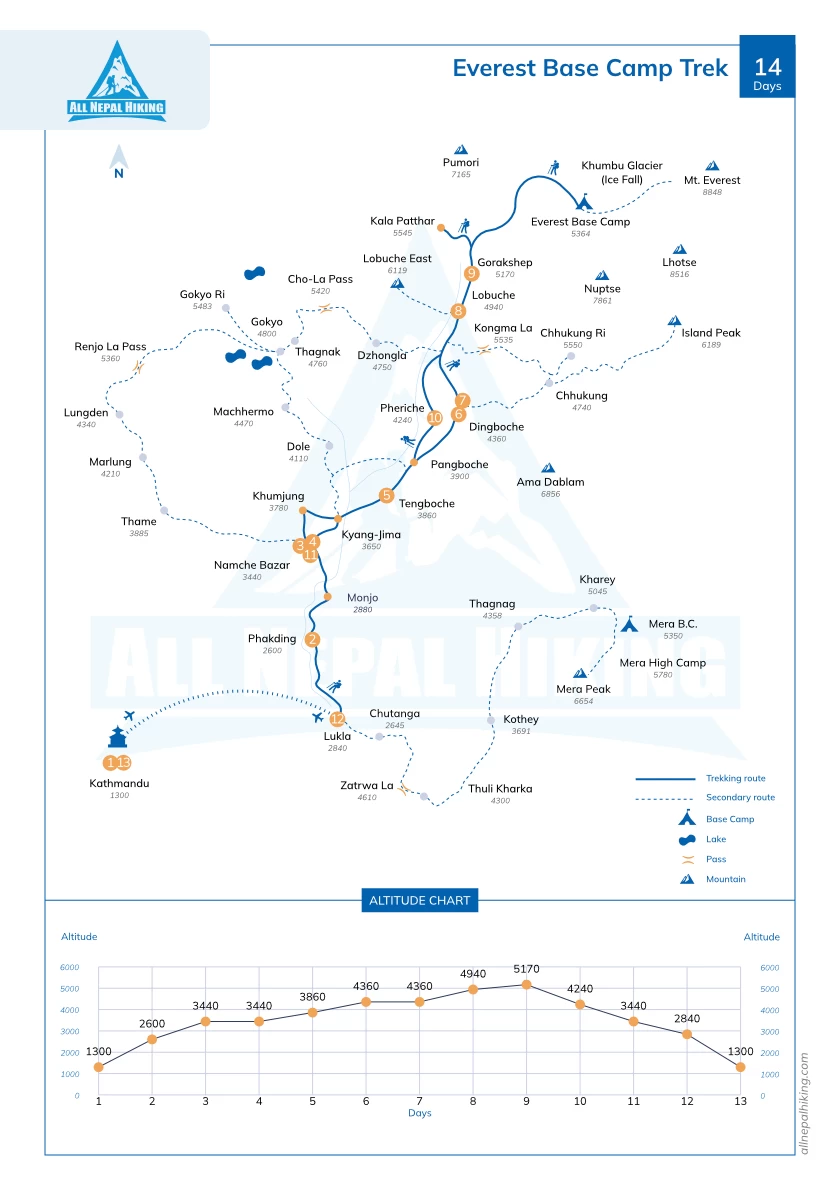
Conclusion
Choosing the right trekking boots for Everest Base Camp is one of the most important steps in your preparation. The boots recommended above are not only suitable for EBC but also versatile for other treks in Nepal and beyond, including Annapurna, Langtang, Mera Peak, and Island Peak.
Remember:
- Buy your boots at home not in Kathmandu so you have time to break them in.
- Comfort and support matter more than brand.
- Always test your boots before the trek.
With the right pair, your Everest Base Camp journey will be safer, more comfortable, and truly unforgettable.
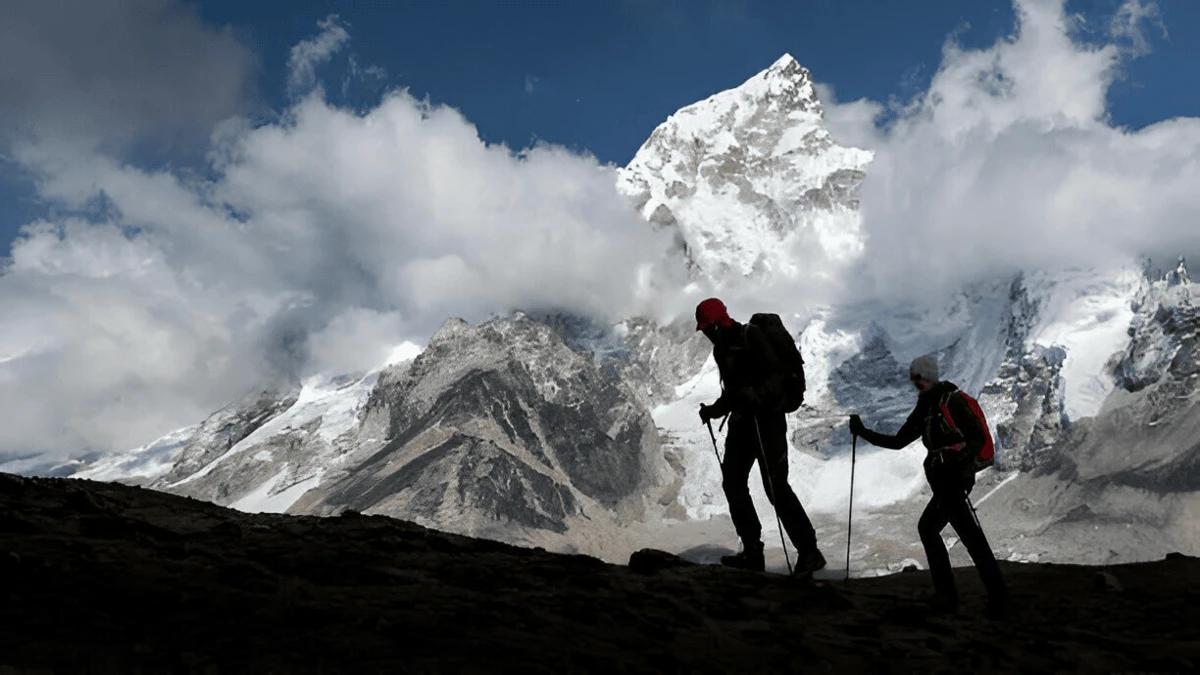



.webp)
